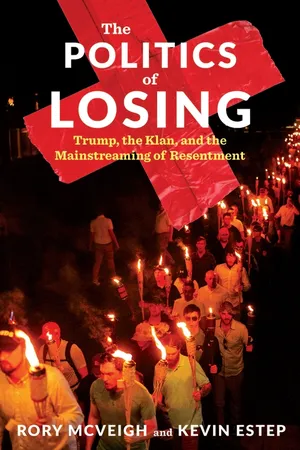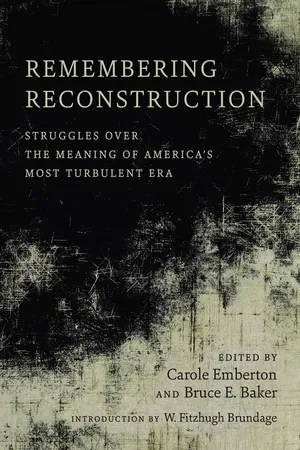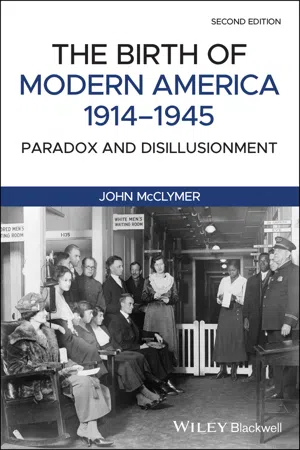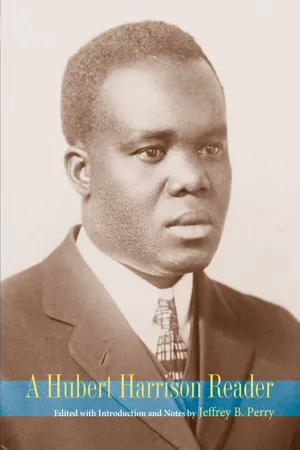History
First KKK
The First KKK, or Ku Klux Klan, was a white supremacist organization founded in the United States in 1865. Its members used violence and intimidation to maintain white supremacy and prevent African Americans from exercising their rights. The group disbanded in the late 1800s but was revived in the early 1900s and again in the 1950s and 1960s during the Civil Rights Movement.
Written by Perlego with AI-assistance
Related key terms
Related key terms
1 of 4
Related key terms
1 of 3
11 Key excerpts on "First KKK"
- eBook - ePub
- Cindy D. Ness(Author)
- 2007(Publication Date)
- Routledge(Publisher)
Most White-supremacist groups in the immediate postbellum period directed their violence at racial minority groups, but the ultimate target of their actions was the state apparatus imposed on the defeated southern states during the Reconstruction era. The quintessential White-supremacist organization of this time – the Ku Klux Klan – emerged in the rural south in the aftermath of the Civil War, inflicting horrific violence on newly emancipated African Americans and their White, especially northern, allies. Organized as loose gangs of White marauders, the first Klan may have had a chaotic organizational structure, but its goals and efforts were focused and clear – to dismantle the Reconstructionist state and restore one based on White supremacism. Women played no direct role in this Klan. Indeed, its mob-like exercise of racial terrorism on behalf of traditional southern prerogatives of White and masculine authority left no opening for the participation of White women except as symbols for White men of their now-lost privileges and lessened ability to protect “their” women against feared retaliation by former slaves (Blee 1991).Racial terrorism in the early twentieth century
The first wave of the KKK collapsed in the late nineteenth century, but its legacy of mob-directed racialized violence continued into the first decades of the twentieth century through extra-legal lynchings and racially biased use of capital punishment to execute African Americans.8 The re-emergence of the Klan in the late 1910s (a Klan that flourished through the 1920s) substituted political organization for mob rule, enlisting millions of White, native-born Protestants in a crusade of racism, xenophobia, anti-Catholicism, and anti-Semitism that included contestation of electoral office in some states. The violence of this second Klan also took a new form, mixing traditional forms of racial terrorism with efforts to instill fear through its size and political clout and create financial devastation among those it deemed its enemies (Blee 1991).The targets of lynchings, racially biased capital punishment, and the 1920s Klan were mostly members of racial, ethnic, and religious minority groups; they also constituted its primary enemies. The racial terror of lynching and racially biased capital punishment both depended on state support, either overtly or covertly. Similarly, for the second Klan, located primarily in the north, east, and western regions rather than the south, the state was not an enemy; instead, it was a vehicle through which White supremacists could enact their agendas. Rather than attack the state, in this period organized racism was explicitly xenophobic and nationalist, embracing the state through an agenda they characterized, in the Klan’s term, as “100% American.” - eBook - ePub
- Tore Bjørgo, Miroslav Mareš, Tore Bjørgo, Miroslav Mareš(Authors)
- 2019(Publication Date)
- Routledge(Publisher)
We present the best information available about the Ku Klux Klan’s vigilantism, but it is important to note that data about the Klan is always partial. As a secret society that is often engaged in illegal actions or plans, the Klan takes care to obscure its leadership, structure, and locations and to exaggerate its size and influence. Even evidence about the Klan from law enforcement or government agencies can be suspect, as some state officials have been sympathetic to the Klan’s violence or reluctant to reveal its ability to pursue vigilante actions with few legal consequences (Blee, 2017; Cunningham, 2012; McVeigh and Cunningham, 2012; (Wright, 1985). The sources on which we rely for data on vigilantism in the Ku Klux Klan thus required extraordinarily complex methods of research to surmount the Klan’s secrecy, intimidation, and sharp difference between publicly available statements of plans and ideologies and what happens within its groups (Blee, 2002).Klan vigilantism across historical periods
1st Klan: 1860s–1870s
The first Klan arose in the wake of the Civil War, which ended with the defeat of the Confederacy, a secessionist movement of southern states that sought to preserve their slavery-based economy and social order. The Klan emerged as a loosely organized association of white men, largely in the rural areas of the South, who wielded vigilante terrorism and violence to defend white supremacy and the racial state. Their name was meant to denote a circle of brothers, suggesting the racial fraternity that would long be a characteristic of Klan groups. Klan targets were primarily emancipated blacks and white northerners who had come to the south to reconstruct the state in the post-Civil War period. Its organization was limited, with officials holding titles such as Grand Dragon that were more symbolic than reflective of an actual integrated organization. Indeed, the Klan’s locally based and largely uncoordinated groups mostly resembled loosely organized gangs.Due to its loose organizational form, the Klan’s vigilante violence was locally targeted with little overall strategy among groups beyond a shared antipathy toward both blacks and the northern, federally directed project of reconstructing the southern racial state. Indeed, it is difficult to identify precisely the acts of violence that are attributable to Klan groups, as white violence against blacks and their white allies was pervasive across the post- Civil war era South. Such violence was both vicious and extensive, taking the form of murders, arsons, lynchings, expulsion from homes and communities, robbery, and enslavement. In the state of Georgia alone, the Freedman’s Bureau cited 336 murders or assaults in 1868, a significant proportion of which might have been related to the Klan, while the Klan was also responsible for burning schools and churches and numerous acts of political intimidation (Bryant, 2002). In one county in South Carolina, white vigilante violence, much likely attributable to Klan members, took the form of whipping, terrorizing, attacking, and even murdering and lynching former slaves who tried to leave their plantations (as well as those that hired them) or who showed disrespect to whites, (for men) approached white women, or were thought to be fomenting insurrection or resistance to white rule (Parsons, 2005; Tolnay & Beck, 1995). Moreover, the Klan in that county was responsible for two large scale raids on jails that ended in deaths after a black militia attempted to block the delivery of illegal liquor to a local hotel (Parsons, 2005). - eBook - ePub
The Politics of Losing
Trump, the Klan, and the Mainstreaming of Resentment
- Rory McVeigh, Kevin Estep(Authors)
- 2019(Publication Date)
- Columbia University Press(Publisher)
By comparing Trump’s rise with that of the Klan we do not mean to equate the two, or exaggerate the extremism of Trump or the people who voted for him. Each time the Klan erupted, it attracted huge followings, drawing in members and supporters who were, in many ways, quite ordinary. On a Saturday night, a Klansman might light a cross and march down Main Street in full hooded regalia. And on Sunday morning he might go to church and picnic with his family in the afternoon. Our comparisons help us explore when and how white nationalist movements emerge, but also how their goals enter the mainstream. We look at the Klan of the 1920s because it was the most effective in attracting broad support, spreading farther and faster than the others. Its growth surprised its contemporaries and still puzzles us today. Understanding it will crack the code of Trump’s own surprising rise to power. But first, we revisit all the Klans of the past.THE RECONSTRUCTION KLANThe first Ku Klux Klan emerged as Southerners dealt with the devastation of the Civil War. Historians estimate that six hundred thousand Americans died in the war, which also destroyed the South’s transportation infrastructure, property, and local economy.1 The Southern elite, in particular, faced the challenge of rebuilding their fortunes—fortunes made through property ownership and slave labor.2 They worried about the economic consequences of emancipation, and feared violent retribution from former slaves and, worse, a coming political revolution that could seize their land.3 Before the Klan came into being, white Southerners already anticipated black threats to institutional white supremacy—and reacted with violence.4This violence was itself an extension of practices developed before the war, when “night riders” patrolled the countryside to capture escaped slaves and intimidate those who might be contemplating escape.5 Slaves were geographically concentrated. A relatively small proportion of Southerners owned the vast majority of slaves, who worked primarily in cotton-growing regions of the Deep South. To ward off rebellion, slave owners would sometimes don white sheets, pretending to be ghosts, in an effort to scare slaves into submission.6 Folklorist Gladys-Marie Fry writes that whites in the South were terrified of the prospects of slave uprisings: “Slaves posed a constant threat, a storm cloud that could erupt at any moment into a hurricane of disaster.”7In 1865, in Pulaski, Tennessee, six Confederate war veterans founded the Ku Klux Klan. It’s not clear how they came up with the name. Two of the original members would later claim that it was meaningless but sounded mysterious.8 These first Klansmen were relatively prosperous and styled themselves as intellectuals: Frank McCord was the editor of the local newspaper; Calvin Jones, John Lester, and Richard Reed were attorneys; James Crowe was a cotton broker; and John Kennedy, it appears, was a well-off farmer, though not a plantation owner.9 Historical accounts say that the men started the group, at first, to relieve boredom. They staged plays and concerts in Pulaski:10 McCord played the fiddle, and Jones played the guitar.11 Some evidence suggests that they were part of the minstrel tradition, performing locally under the name of the “Midnight Rangers.”12 - eBook - ePub
I Heard It Through the Grapevine
Rumor in African-American Culture
- Patricia A. Turner(Author)
- 2023(Publication Date)
- University of California Press(Publisher)
other white supremacists not formally affiliated with the Klan. Consequently, the Klan’s power is often stronger in the minds of many African-Americans than it is in actual fact.Founded by a group of six bored and dissatisfied ex-Confederate soldiers in 1866 in Pulaski, Tennessee, the KKK with its outlandish garb and highly ritualized activities has remained a nemesis to African-Americans throughout its one- hundred-plus-year history. Although its very first activities resembled modern-day fraternity pranks more than malicious assaults, within several months the group’s signature night rides and brutal violence, with blacks the central target, began to dominate the group’s ill-conceived agenda.The Birth of the Klan3Like the paterollers of the antebellum South, the KKK of the 1860s and 1870s employed an extensive repertoire of tricks and scare tactics in their attempts to keep Reconstruction-era free blacks “in their place.” Many of these antipathy-laden escapades added new meaning to the “cruel and unusual punishment” idiom. Understanding why African-Americans have attributed corporate conspiracies as well as random unsolved racially motivated crimes to the KKK necessitates an understanding of just how perverse and destructive the KKK’s verifiable crimes have been.Both the era of Reconstruction—when “radical” Republicans based in the North worked to shift the white supremacist order and mindset of the Confederacy and create a more humble, egalitarian “new” South—and the first incarnation of the Ku Klux Klan span the years 1866—72. Although many of the techniques used by the postwar KKK were clearly inspired by the antebellum paterollers, changed economic, social, and political circumstances in the reunited nation had altered the balance of power in the South. Whereas prior to the war black lives were valuable commodities deserving of protection by the whites, after the war the economic incentives of property investment no longer applied. A political division thus - eBook - ePub
Remembering Reconstruction
Struggles over the Meaning of America's Most Turbulent Era
- Carole Emberton, Bruce E. Baker, Carole Emberton, Bruce E. Baker(Authors)
- 2017(Publication Date)
- LSU Press(Publisher)
22This passage is less extensive than Gilman’s, and more critical. It introduces a claim common in textbooks up through the 1950s that while the Klan might have been justified in the beginning (Johnston had spent the previous few paragraphs describing the chaos of Negro rule), it quickly became unjustifiable as less elite white men moved in. Yet even in this fairly critical passage, the Klan emerges as an organized response to black ineffectiveness, stands in for white-on-black violence generally, and is not presented as part of a longer pattern or tradition of racial oppression.George F. Holmes’s New School History of the United States, a year later, included a still briefer mention. Holmes was an adopted southerner and a professor at the University of Virginia.23A strange, secret, and undiscoverable body, called the Ku-Klux Klan, excited much alarm among the freedmen of the more Southern States, and provoked rigorous proceedings on the part of the majority in Congress. The Military Enforcement Act was the most stringent of these measures.24This passage, with its use of the word strange, is the first to introduce the important theme of the Klan’s inscrutability. A less Klan-sympathetic textbook published by the California State system in 1888 was the fourth in the collection to mention the Klan, as a secret society formed to “keep the negroes in subjection,” which was violent but was soon suppressed by the federal government and better class of southern whites.25 One by John Fiske, an instructor at Harvard, was the fifth. It reiterated that the Klan emerged as a response to black misgovernment, “sometimes committed deeds of violence,” and disappeared when the better southern whites stepped up to end it.26 Not surprisingly, a year ahead of Fiske, Woodrow Wilson’s 1893 text, Division and Reunion had apparently been at the cusp of mentioning the Klan. The name “Ku Klux” appears nowhere in his text, nor does he mention that a particular organized entity was involved, but he has an (approving) section on white-on-black political violence, and whoever placed subheadings along the sides of the text labeled this section “Ku-Klux Movement.”27 Wilson would more than rectify the omission in his extensive treatment of the Klan in his 1902 A History of the American People.28 - eBook - ePub
Steel Valley Klan
The Ku Klux Klan in Ohio's Mahoning Valley
- William D. Jenkins(Author)
- 2014(Publication Date)
- The Kent State University Press(Publisher)
By November 1923, however, the Klan had changed Warnock’s mind. He became not only a member but eventually a grand titan (district official). Warnock and many other local residents had assumed that the Klan would duplicate the violent and disruptive activities of the earlier organization. Gradually they came to view the Klan as a protector, rather than a violator, of the moral and legal order, an organization worthy of northern Protestant Christians’ support. In their minds the Klan of Reconstruction was dead. A new Klan had arisen.The Klan of Reconstruction had sought the control of race relations in the South after the Civil War. The granting of political rights to freed blacks posed a threat to white supremacy and might lead, the Klan feared, to social equality. The beatings, whippings, tar and featherings, and lynchings used to intimidate blacks politically and socially eventually caused the federal government to outlaw the Klan in 1871. Members then joined similar organizations, such as the Knights of the White Camelia. By the 1890s the North had grown weary of intervention, thereby permitting southern states to pass laws disfranchising blacks and segregating them from white society.Refounded in 1915 by Colonel William J. Simmons, the new Ku Klux Klan also emphasized white supremacy but differed from the earlier Klan in its emphases on fraternalism, nativism, and moralism. After failing as a clergyman and salesman, Simmons had found some professional success as a district organizer for the Woodmen of the World, one of the many fraternal societies joined by Americans of that era. Realizing the popularity of a secret society with elaborate rituals and passwords, Simmons fashioned a Klan that would appeal to the fraternal sentiments of American society—a Klan with acronyms functioning as a secret language, strange-sounding titles like kleagle, grand goblin, and imperial wizard, and a system of rituals known only to members. Simmons’s charter, obtained from the state of Georgia, described the organization as a “patriotic, military, benevolent, ritualistic, social and fraternal order.” Once a month local meetings, complemented by family picnics and parades, created a sense of camaraderie that appealed to native-born, white, Anglo-Saxon, Protestant men.2 - eBook - ePub
- Henry P. (Henry Peck) Fry(Author)
- 2010(Publication Date)
- Perlego(Publisher)
A careful investigation of the history of the original movement shows that it was divided into three separate and distinct periods. It was first organized as a secret society for the amusement of its members, without any serious attempt to act as a “regulator” of social and political affairs; it was then transformed into a great political-military movement, enforced law and order, drove the negro and the carpetbagger out of politics, and was then ordered disbanded; and lastly it attempted in unorganized fashion, without the authority of its former leaders, to rule many communities, and an enormous number of acts of violence were committed either by it or in its name.There were several different organizations which sprang into existence in the South during the reconstruction periods, each one operating along the same general lines but bearing different names. There were the Ku Klux Klan, the White Brotherhood, the Pale Faces, the Constitutional Union Guards, and the Knights of the White Camelia, which was larger than any of them. In the latter days of the reconstruction, when acts of lawlessness in the South were so bad that an investigation was held by Congress, the general name of Ku Klux was applied to all extra-legal Southern movements. As this narrative deals only with the Ku Klux Klan, a discussion of the other movements is unnecessary.The Ku Klux Klan was organized in Pulaski, Tenn., in May, 1866. Several young men who had served in the Confederate Army, having returned to their homes, found themselves suffering from the inactivity and reaction that followed army life. There was nothing to do in which to relieve it. There was but little work to do, and but few had capital to engage in new mercantile or professional pursuits. The amusements and diversions of normal society were lacking, and to meet this situation, it was decided to form a secret society merely for the purpose of burlesque and fun-making. After the society was organized, and a name was sought, one of the members suggested the word “kukloi” from the Greek word “Kuklos - eBook - ePub
The Birth of Modern America, 1914 - 1945
Paradox and Disillusionment
- John McClymer(Author)
- 2021(Publication Date)
- Wiley-Blackwell(Publisher)
Comparisons of the first and second Klans yield a great many differences as well. The first Klan sought to put newly freed blacks back in “their place,” i.e., to restore white supremacy. The second, while also hostile to African Americans who tried to live as first‐class citizens, defined “white supremacy” to mean the ascendancy of “Nordic Americans” over all others. The members of the first Klan were overwhelmingly Protestant, but anti‐Catholicism formed no part of their movement. Nor did anti‐Semitism. Nor did nativism. The first Klan fixated entirely upon the immediate issues of Reconstruction. Moreover, while local klaverns of the second Klan did engage in “night riding” and other forms of vigilante activity, this was not the sole focus of the KKK of the 1920s. In fact, Imperial Wizard Evans and other Klan leaders sought, at least publicly, to distance the organization from the “invisible government” actions of the immediate postwar years and to insist upon the Klan’s reverence for established legal authority. The first Klan, in short, was a paramilitary organization; the second was not. Still another important difference is the second Klan’s insistence upon “Americanism.” The first was an organization of white Southern males. The second attracted support from all sections and from women.Some in the 1920s suggested a different historical comparison, the Know Nothing movement of the 1850s. Writing in the North American Review of January 1924, William Starr Myers noted that the Klan, “with the possible exception of masks, robes, and other like paraphernalia,…is an almost complete replica of the old Know Nothing movement of the ‘fifties of the last century.”The Know Nothing party…spread over the eastern and northern sections of the country, with Grand Councils, Superior Councils, Subordinate Councils, and all the other hierarchy of a well thought out and clear cut organization. It had a grip, pass words, secret signs, and much of the ritual that has proved so attractive to the average American citizen, whether the object of an organization be fraternal, social, political, or religious. It was organized in opposition to the naturalization of foreign immigrants, then first coming to the United States in large numbers, and also opposed to the activities and spread of the Roman Catholic Church.Unlike the Klan, the Know Nothings, aka the Native American Party, were not necessarily hostile to African Americans. In fact, in states like Massachusetts, the Know Nothings vehemently denounced the Kansas‐Nebraska Act and the Fugitive Slave Law. In Worcester, a center of Know Nothingism, the party swept the 1854 municipal elections as its newspaper, the Daily Evening Journal - eBook - ePub
- Robert Kumamoto(Author)
- 2014(Publication Date)
- Routledge(Publisher)
33 It is the juxtaposition of petty offenses committed by their victims with unspeakable retributive atrocities committed by the Klan which set the Invisible Empire apart from any other terrorist group in American history.By the fall of 1868, the Ku Klux Klan had established dens in all states of the former Confederacy, including Kentucky, which had remained loyal. In some states, such as Virginia and Florida, violence was minimal, but, as the November elections approached, several states experienced an unprecedented wave of violent activity. During the spring, Republicans, backed by the black vote, had won several elections, and southern Democrats vowed that things would be different in the fall. During the months preceding November and during the election itself, the Klan began a wholesale campaign of intimidation, threats, outrages, and murder in order to manipulate the vote. Hooded nightriders terrorized black communities, warning them to stay away from the polls. Crowds of armed thugs surrounded polling places, intimidating voters and creating a volatile environment. Black and white Republicans who did attempt to vote were routinely beaten with brickbats and pistols and driven into hiding. Republican ballots were destroyed or confiscated. Many blacks voted the Democratic ticket under direct threats to their lives. In several areas, dozens of blacks were jailed on trumped up charges just before election day, and were suddenly released after the polls had closed. State testimony regarding election fraud in Louisiana revealed that during 1868 alone, leading up to the November elections, there were 297 persons killed in the parishes adjacent New Orleans and a total of 784 statewide.34 Forty were killed or wounded in New Orleans.35 In Georgia during the same time period, there were 336 incidents of murder or intent to kill.36 According to reports submitted to the governor’s office, more than 200 murders were committed in Arkansas during the three months preceding the November elections.37 The Joint Select Committee also read and published testimony declaring that, during a six-month period in 1868, there averaged in Tennessee a Ku Klux Klan murder every 24 hours.38 - eBook - ePub
- Hubert Harrison, Jeffrey B Perry, Jeffrey B Perry(Authors)
- 2021(Publication Date)
- Wesleyan University Press(Publisher)
Ku Klux Klan: Its Origin, Growth and Disbandment].But if we have the date of its organization thus fixed, it is an evident absurdity to argue, as The World and so many others do today, that the Klan was organized to put down “black supremacy,” or to keep the Negroes from the ballot box. For the Southern Negro was not given the ballot box until 1866 [HH changed this to 1868]! Indeed, it was the attitude of the South toward the Negro as illustrated by the Ku Klux killings and whippings, and the legislation above described (the celebrated Black Code), which forced Congress to give the ballot to the Negro in order that he might be able to protect himself from the unreconstructed slavists.When Congress met in December, 1865, it considered the Black Code and the other facts of the situation. It found that, if the fruits of victory were not to go to the losers in the conflict, it had to take some drastic steps. The first of these steps was the passing of the Thirteenth Amendment to the United States Constitution, forever abolishing slavery; since Lincoln’s proclamation was only a war measure and did not free all the slaves. It made the acceptance of this amendment a condition precedent to re-entry into the union and submitted it as such to the conquered Confederacy. But the South would not accept it. As Congressman James A. Garfield said, “The last one of the sinful ten, (I quote from memory) has flung back into our teeth with scorn the magnanimous offer of a generous nation.”There could be no better indication of the rebels’ intentions toward the Negro. Congress thereupon divided the South into military districts, each of which was under the command of a major-general of the United States Army, and proceeded to elaborate and enact the Fourteenth and Fifteenth Amendments, and to govern the rebellious States under martial law until they should accept the three war amendments. And, in the meanwhile, the government strove to effect civil reconstruction. When, finally, in 1868, the South was reconstructed, the Negroes, as the largest body of people who were loyal to the United States, aided by white ex-soldiers from the North and a handful of white Southerners played, of necessity, a large part in that process, and it is noteworthy that, within less than two years from the time that the Negro got the ballot, the Ku Klux was disbanded. - Susan R. Burgess, Kathryn C. Leeman(Authors)
- 2016(Publication Date)
- CQ Press(Publisher)
Chapter 5 ), and to the passage of the 1964 Civil Rights Act, which banned racial segregation in public accommodations, restricted discriminatory hiring and housing practices, and empowered the federal government to bring lawsuits and revoke funding of public school systems that failed to integrate. United Klans of America members were implicated in some of this violence, including the July 11, 1964, murder of Lt. Col. Lemuel Penn, a Black World War II veteran who was fatally shot while driving through Clarke County, Mississippi, on his way home from Army Reserve training.In the wake of this dramatic upsurge in Klan violence, President Lyndon B. Johnson and Attorney General Robert Kennedy pressured FBI director J. Edgar Hoover to take a more active role in restoring order in the South. Prior to this time, Hoover had viewed the civil rights movement’s civil disobedience and purported ties to communism as a greater threat to national security than the Klan, generally considering the investigation and prevention of White supremacist violence as a state law enforcement issue (see Chapter 5 ).134 However, in September 1964, Hoover established a secret program that came to be known as COINTELPRO–White Hate, an offshoot of an earlier secret FBI counterintelligence program called COINTELPRO, established in 1956 to target communist groups operating within the United States (see Chapter 2 ). Although the FBI increasingly assisted local law enforcement in the investigation of Klan crimes, the bureau was less interested in obtaining convictions in court than in disrupting and discrediting the Klan, both internally and externally. In a memo to agents regarding the establishment of this counterintelligence program, the director of the FBI’s Domestic Intelligence Division wrote, “We intend to expose to public scrutiny the devious maneuvers and duplicity of the hate groups; to frustrate any efforts or plans they may have to consolidate their forces; to discourage their recruitment of new or youthful adherents; and to disrupt or eliminate their efforts to circumvent or violate the law.”135
Index pages curate the most relevant extracts from our library of academic textbooks. They’ve been created using an in-house natural language model (NLM), each adding context and meaning to key research topics.
Explore more topic indexes
Explore more topic indexes
1 of 6
Explore more topic indexes
1 of 4










